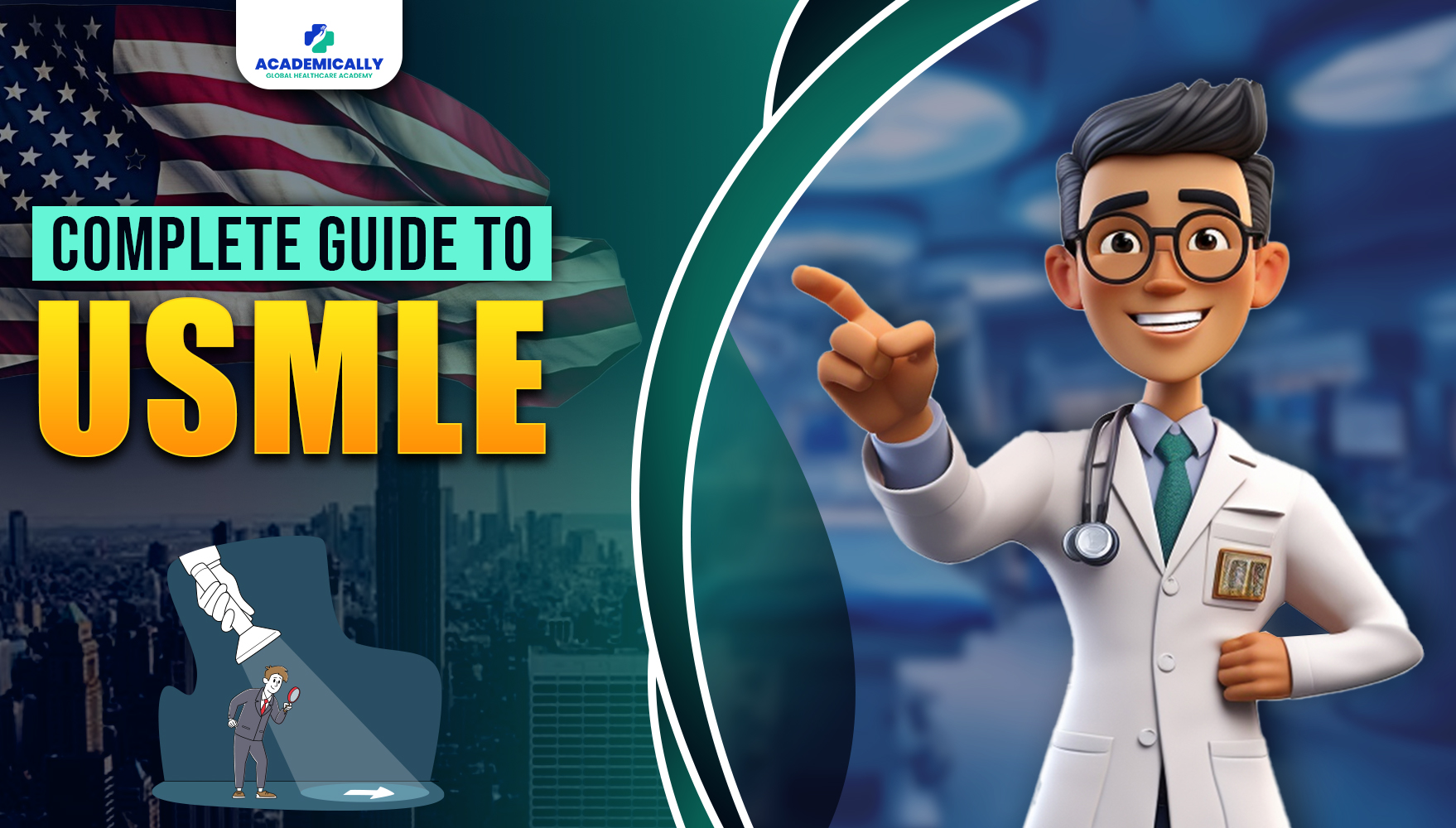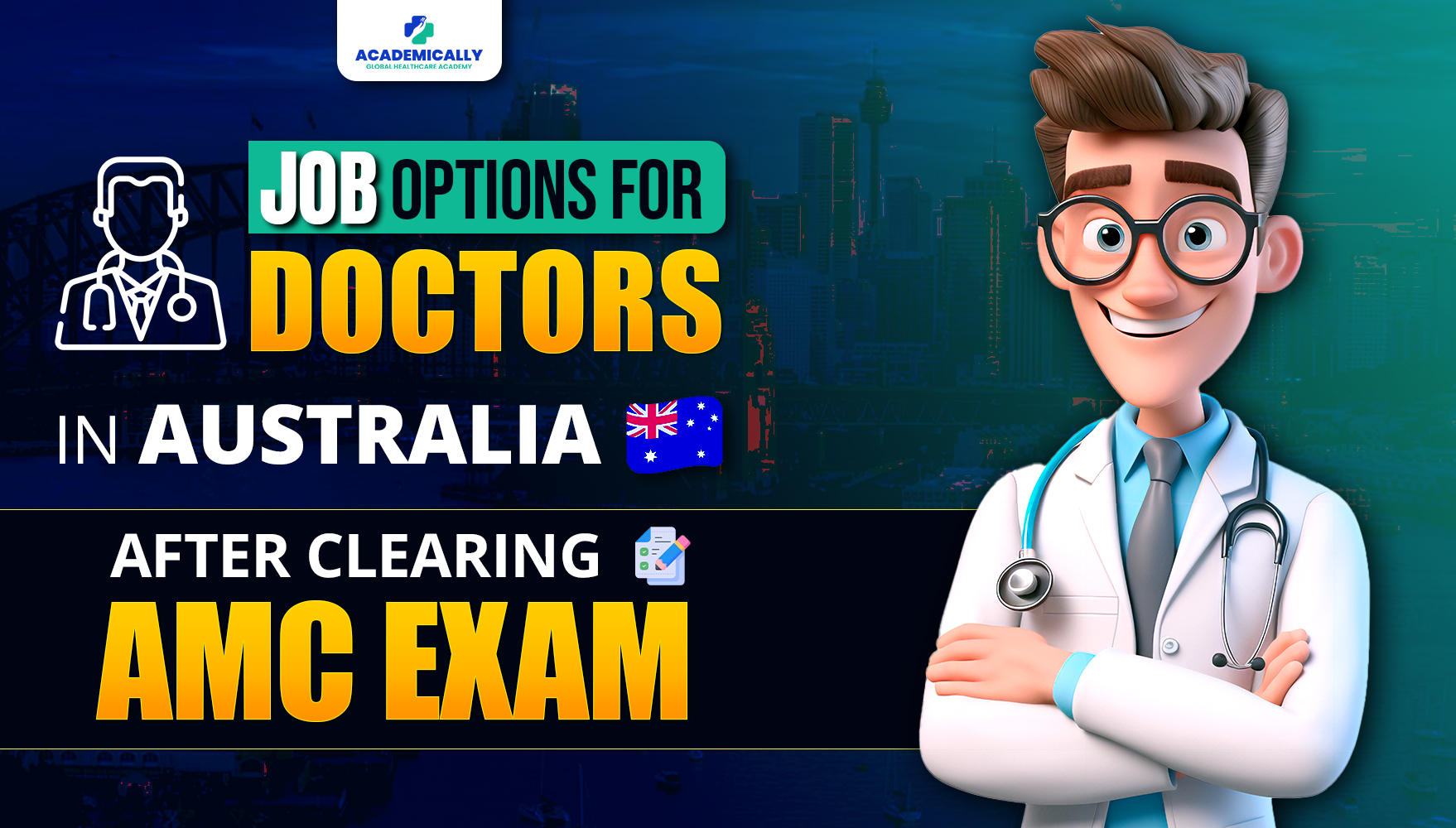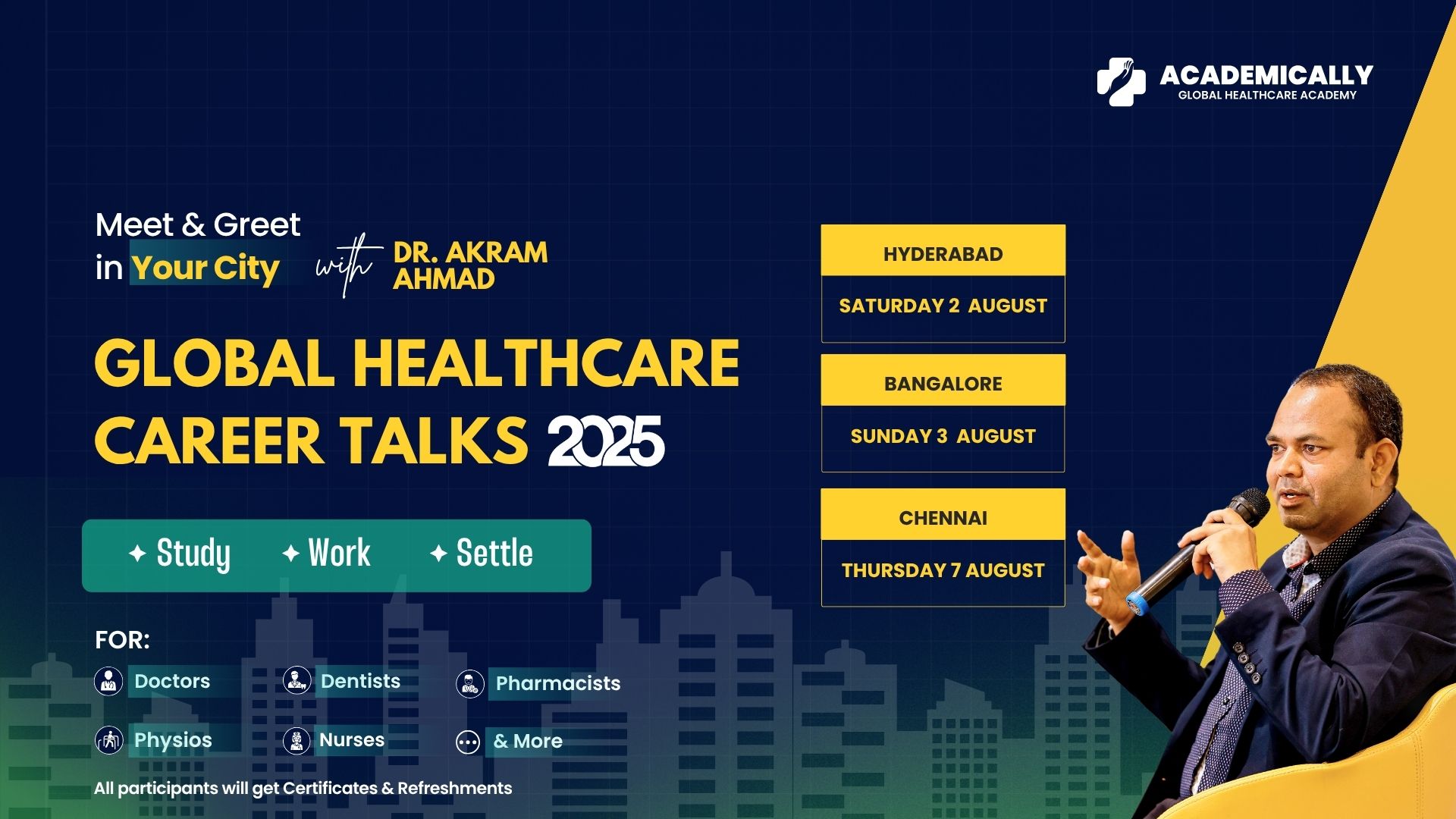What is the USMLE Exam?
USMLE is the United States Medical Licensing Examination. It is the exam you have to take to become a doctor in the USA.
This exam consists of three steps that evaluate a physician’s ability to apply knowledge, concepts, and principles. To work in the US, it is mandatory to pass the USMLE, whether you are from the US or another country.
What is the eligibility for the USMLE Exam?
Eligibility depends on whether you’re studying in the U.S./Canada or you’re an international medical graduate (IMG).
| Criteria | U.S./Canadian Medical Students | International Medical Graduates (IMGs) |
| Medical School Accreditation | LCME (MD programs) or COCA (DO programs) | Listed in the World Directory of Medical Schools (WDOMS) |
| Enrollment Status | Enrolled or graduate | Enrolled or graduate |
| Sponsor Note Requirement | Not required | School must have an ECFMG-eligible sponsor note |
| Registration Body | NBME or FSMB | ECFMG |
| Additional Requirements | None | Must meet ECFMG identity/document criteria |
Note: If you’re an MBBS graduate from India, you’re considered an IMG and must register via ECFMG before taking any USMLE Step.
Do you think you are eligible for the USMLE?
USMLE Exam Structure
The USMLE is divided into three distinct steps. Each step is designed to test a different aspect of your readiness to practice medicine in the U.S.
Step 1: Basic Sciences
- Purpose: Assesses your understanding of core science concepts essential for practicing medicine.
- Subjects Covered: Anatomy, physiology, biochemistry, pathology, microbiology, pharmacology, and behavioral sciences.
- Format: Approximately 280 multiple-choice questions, divided into seven 60-minute blocks.
- Duration: One-day exam lasting about 8 hours.
- Scoring: Pass/Fail
Note: Even though it’s pass/fail, a strong performance on Step 1 lays the foundation for doing well in later steps and your residency.
Step 2 CK (Clinical Knowledge)
- Purpose: Tests your ability to apply medical knowledge to real clinical scenarios.
- Subjects Covered: Internal medicine, surgery, pediatrics, obstetrics and gynecology, psychiatry, and more.
- Format: Around 318 multiple-choice questions, across eight 60-minute blocks.
- Duration: One-day exam of 9 hours.
- Scoring: Scored on a three-digit scale. A strong score is crucial for competitive residency programs.
Note: Step 2 CS (Clinical Skills) has been discontinued.
Step 3: Clinical Practice Readiness
- Purpose: Assesses whether you are ready for unsupervised medical practice.
- Eligibility: Can be taken only after passing Step 1 and Step 2 CK, and after obtaining ECFMG Certification (for IMGs).
- Format:
- Day 1 (Foundations of Independent Practice): Multiple-choice questions.
- Day 2 (Advanced Clinical Medicine): Multiple-choice questions plus 13 computer-based case simulations.
- Duration: Two days.
- Scoring: Three-digit score; minimum passing score is 198 (as of latest update).
| USMLE Step | Focus Area | Key Topics | Format & Duration | Eligibility | Scoring |
| Step 1 | Basic Sciences | Anatomy, Physiology, Biochemistry, Pathology, Pharmacology | 280 MCQs in 7 blocks over 8 hours | After pre-clinical years | Pass/Fail |
| Step 2 | Clinical Knowledge | Internal Medicine, Surgery, Pediatrics, Psychiatry, OB/GYN | 318 MCQs in 8 blocks over 9 hours | After clinical rotations or internship | 3-digit score (Min. 209) |
| Step 3 | Independent Medical Practice | Clinical Decision-Making, Case Simulations | Day 1: MCQs, Day 2: MCQs + 13 CCS cases | After Step 1, Step 2 CK, and ECFMG Certification (for IMGs) | 3-digit score (Min. 198) |
USMLE Syllabus
Step 1 Syllabus
| System | Range, % |
| Pathology | 45-55 |
| Physiology | 30-40 |
| Pharmacology | 10-20 |
| Biochemistry & Nutrition | 5-15 |
| Microbiology | 10–20 |
| Immunology | 5–15 |
| Gross Anatomy & Embryology | 10-20 |
| Histology & Cell Biology | 5-15 |
| Behavioral Sciences | 10-15 |
| Genetics | 5–10 |
Step 2 Syllabus
| Competency | Range, % |
| Medicine | 55–65 |
| Surgery | 20–30 |
| Obstetrics & Gynecology | 10–20 |
| Psychiatry | 10–15 |
| Pediatrics | 17–27 |
Step 3 Syllabus
Foundations of Independent Practice (Day 1)
| Competency | Range, % |
| Medical Knowledge: Applying Foundational Science Concepts | 11–12 |
| Patient Care: Diagnosis | 33–36 |
| History/Physical Exam | 5–9 |
| Laboratory/Diagnostic Studies | 9–12 |
| Diagnosis | 6–10 |
| Prognosis/Outcome | 8–11 |
| Patient Care: Management | 32–35 |
| Health Maintenance/Disease Prevention | 6–11 |
| Pharmacotherapy | 9–13 |
| Clinical Interventions | 5–9 |
| Mixed Management | 6–11 |
| Practice-based Learning & Improvement | 11–13 |
| Communication / Professionalism / Systems-based Practice & Patient Safety | 7–9 |
Advanced Clinical Medicine (Day 2)
| Competency | Range, % |
| Medical Knowledge: Applying Foundational Science Concepts | 11–12 |
| Patient Care: Diagnosis | 33–36 |
| History/Physical Exam | 5–9 |
| Laboratory/Diagnostic Studies | 9–12 |
| Diagnosis | 6–10 |
| Prognosis/Outcome | 8–11 |
| Patient Care: Management | 32–35 |
| Health Maintenance/Disease Prevention | 6–11 |
| Pharmacotherapy | 9–13 |
| Clinical Interventions | 5–9 |
| Mixed Management | 6–11 |
| Practice-based Learning & Improvement | 11–13 |
| Communication and Professionalism | 7–9 |
All this might seem too much. But don’t worry, you can do it easily with a bit of help. For an exam of this magnitude you need to enroll in a coaching program. A program that gives you live and recorded lectures, study materials, practice questions, AI-based mock tests, personalised guidance and much more. This way you can pass the USMLE in the first attempt.
Wondering where you will get all this? The answer is simple- Academically’s USMLE Preparation Course is the best one out there. You can join and see for yourself.
USMLE Test Centers (Step 1 & Step 2 CK)
The USMLE Step 1 and Step 2 CK exams are administered at Prometric test centers worldwide. Prometric is the official testing partner for the NBME (National Board of Medical Examiners) and FSMB (Federation of State Medical Boards), the co-sponsors of the USMLE.
- USMLE Step 1 & Step 2 CK can be taken at over 400 Prometric centers globally.
- USMLE Step 3 is only conducted in the United States and its territories at designated Prometric centers.
| Testing Region | Countries/Locations |
| United States & Canada | USA (all 50 states), Guam, Puerto Rico, Virgin Islands, Canada (Alberta, BC, Manitoba, Newfoundland & Labrador, Nova Scotia, Ontario, Quebec, Saskatchewan) |
| Africa | Ghana, Kenya, South Africa, Uganda |
| Asia | Bangladesh, Malaysia, Pakistan, China (PRC), Philippines, Singapore |
| Australia | Australia, New Zealand |
| China | People’s Republic of China |
| Europe | Armenia, Croatia, Denmark, France, Germany, Greece, Ireland, Israel, Italy, Latvia, Netherlands, Portugal, Spain, Switzerland, Turkey, United Kingdom |
| India | Multiple cities across India |
| Indonesia | Indonesia |
| Japan | Japan |
| Korea | Korea |
| Latin America | Argentina, Bolivia, Brazil, Chile, Colombia, Costa Rica, Dominican Republic, Guatemala, Mexico, Peru, Trinidad & Tobago, Venezuela |
| Middle East | Egypt, Jordan, Kuwait, Lebanon, Oman, Qatar, Saudi Arabia, UAE |
| Taiwan | Taiwan |
| Thailand | Thailand |
USMLE Exam Centres in India
| State | City |
| Gujarat | Ahmedabad |
| Karnataka | Bangalore |
| Uttar Pradesh | Allahabad |
| Tamil Nadu | Chennai |
| Telangana | Hyderabad |
| West Bengal | Kolkata |
| Maharashtra | Mumbai |
| New Delhi (NCR) | Gurgaon |
USMLE Step 3 Test Centers
| Exam | Availability | Locations | Booking Platform |
| Step 3 | Only in the U.S. | U.S. States & Territories only | Prometric USMLE Site |
When Is the USMLE Exam Conducted?
The USMLE exam is conducted year-round; there are no fixed exam dates.
- Step 1 and Step 2 CK are offered throughout the year at Prometric centers worldwide, depending on seat availability.
- Step 3 is available on selected dates and only at Prometric centers in the United States and its territories.
Important: You must schedule your exam within your assigned eligibility period (typically a 3-month window). Booking early is advised, especially during peak seasons.
How to Apply for the USMLE
1. Create an ECFMG Account (IWA)
Register at ECFMG IWA to get your USMLE/ECFMG ID.
2. Submit Application for Step 1/2 CK
- Provide personal and educational details
- Upload necessary documents (transcripts, passport copy, photo)
- Pay exam fee
3. Wait for ECFMG Verification
Takes 2–6 weeks depending on your medical school.
4. Receive Scheduling Permit
You’ll get an email with a permit to schedule via Prometric.
5. Book Exam Slot at Prometric
Choose your preferred center and available dates.
What Happens After You Pass the USMLE?
Once you clear all steps of the USMLE:
- You can apply for residency in the U.S. through the National Resident Matching Program (NRMP).
- You’ll need to secure ECFMG Certification (for IMGs).
- You can then apply for a state medical license after completing residency.
How to Apply for USMLE After MBBS in India – A Roadmap
Confirm Medical School is listed in WDOMS
↓
Create an account at ECFMG (via IWA portal)
↓
Submit online application + documents to ECFMG
↓
Wait for ECFMG verification & receive ECFMG ID
↓
Register for USMLE Step 1 via ECFMG
↓
Schedule your test via Prometric once eligibility period is confirmed
↓
Take USMLE Step 1
↓
[8] Repeat process for Step 2 CK
↓
After passing Step 1 & Step 2 CK → Apply for ECFMG Certification
↓
Register for Step 3 via FSMB (after ECFMG Certification)
USMLE Timeline After MBBS (India to USA)
| Stage | Timeline | What You Should Do |
| MBBS (India) | 5.5 years | Complete your degree and internship |
| Final Year MBBS | Start early (you can prepare and take the exam from 2nd year) | Begin preparing for USMLE Step 1 |
| After MBBS | 6-12 months | Apply to ECFMG, take Step 1 |
| Post Step 1 | 6 months | Take Step 2 CK |
| After Step 2 CK | 2–3 months | Apply for electives/observerships (optional but helpful) |
| ECFMG Certified | 3–6 months | Take Step 3 and apply for residency via NRMP |
| Residency | 3–7 years | Based on specialty in the U.S. |
| State License | Post-residency | Eligible for full licensure and independent practice |
USMLE Exam Fees (2025)
Here’s what you can expect to pay as an IMG:
| Exam | Base Fee (USD) | International Center Surcharge | Approx. Total |
| Step 1 | $1,020 | $205 | $1,225 |
| Step 2 | $1,000 | $230 | $1,250 |
| Step 3 | $925 | Not applicable (U.S. centers only) | $925 |
USMLE Pass Rate Trends (2023–2024)
| USMLE Step | Category | 2023 Pass % | 2024 Pass % | Notes |
| Step 1 | US/Canada MD (1st attempt) | 92% | 91% | Slight dip in 2024 |
| IMGs (1st attempt) | 72% | 73% | Marginal increase | |
| IMGs (Repeaters) | 47% | 52% | Improved significantly | |
| Step 2 | US/Canada MD (1st attempt) | 98% | 98% | Consistently high |
| IMGs (1st attempt) | 88% | 89% | Slight growth | |
| IMGs (Repeaters) | 60% | 61% | Stable performance | |
| Step 3 | US/Canada MD (1st attempt) | 97% | 97% | Stable |
| IMGs (1st attempt) | 92% | 89% | Slight dip | |
| IMGs (Repeaters) | 64% | 64% | No change |
Common Mistakes to Avoid During USMLE Preparation
1. Underestimating Step 1 after the pass/fail shift it still matters.
2. Starting late, preparation can take 12–18 months if done right.
3. Ignoring clinical skills, especially relevant for Step 2 CK and interviews.
4. Skipping NBME practice exams, critical for real exam readiness.
5. Using too many resources, stick to 2–3 high-yield sources per step.
6. No timeline or backup plan, USMLE is a long journey, plan every stage.
Job Opportunities After USMLE
Once you pass all three USMLE steps and complete your U.S. residency training, a wide range of job opportunities open up.
Clinical Career Options:
1. Hospital-Based Practice – Work as an attending physician in a U.S. hospital (private or government-funded).
2. Private Clinics & Group Practices – Join or establish your own medical practice, depending on state licensing.
3. Fellowship & Super-Specialization – After residency, you can pursue further training in competitive specialties like cardiology, gastroenterology, or oncology.
4. Telemedicine – Growing demand in remote patient care allows for flexible work settings.
Non-Clinical Career Opportunities:
- Medical Research – Join research teams at academic institutions or pharma companies.
- Public Health – Work in organizations like CDC, WHO, or local health departments.
- Medical Writing & Education – Write or teach for U.S. boards, prep platforms, or academic institutions.
- Health Tech Startups – Join roles in health policy, clinical software development, or innovation labs.
- Medical Consulting – Advise hospitals, legal firms, or global health agencies.
Many IMGs also return to India after USMLE and U.S. residency, securing high-paying roles in private hospitals, medical colleges, or launching their own practice with strong global credentials.
In-Demand Specialties for IMGs in the U.S.:
| Specialties | Reason for Demand |
| Internal Medicine | High patient load, hospitalists need |
| Family Medicine | Primary care shortage in many states |
| Psychiatry | Severe shortage across the U.S. |
| Pediatrics | Increasing demand in underserved areas |
| Pathology | Behind-the-scenes but essential role |
PR / Visa Options After USMLE
Residency and work in the U.S. are only part of the journey; understanding visa and permanent residency (PR) options is equally important.
Visa Pathways During and After USMLE:
1. J-1 Visa (Training Visa):
- Most commonly issued for residency/fellowship.
- Sponsored by ECFMG.
- Requires doctors to return to their home country for 2 years after training (unless waived).
2. Conrad 30 Waiver Program:
- Let's J-1 visa holders stay in the U.S. after training without the 2-year home return rule.
- You must work in a medically underserved area for 3 years.
3. H-1B Visa (Work Visa):
- Allows doctors to work in residency/fellowship or after training.
- Some hospitals directly sponsor this (preferred by many IMGs as it has no home return rule).
- Valid for up to 6 years (can be extended if applying for PR).
Green Card (Permanent Residency) Options After USMLE:
| Pathway | Description | Timeframe |
| EB-2 via Employer | Hospital or clinic sponsors you | 1–3 years (based on country of origin) |
| NIW (National Interest Waiver) | For physicians working in underserved areas | Eligible immediately after 5-year service |
| EB-1 (Extraordinary Ability) | Rare for doctors with awards, publications, and global impact | 1–2 years |
| Marriage-Based PR | If married to a U.S. citizen | 6–12 months |
U.S. Citizenship:
After holding a green card for 5 years, you can apply for U.S. citizenship.
Many Indian doctors follow this path: J-1 visa → Conrad waiver job → EB-2 green card → U.S. citizenship.
Are you confused about which visa will suit you best? Get expert advice to make the right decision.
How to Stay Motivated Through the USMLE Journey
- Set weekly and monthly study targets.
- Use study groups and online forums like Reddit (r/step1) or USMLE-Rx.
- Watch success stories on YouTube for inspiration.
- Reward yourself after finishing key milestones like Step 1 or NBME assessments.
- Keep your long-term U.S. goal in mind, residency, specialization, and finally independent practice.
USMLE vs Other Licensing Exams
| Exam | Country | Structure | Duration | IMG Friendly? |
| USMLE | USA | Step 1, Step 2 CK, Step 3 | 1–2 years | Yes (via ECFMG) |
| PLAB | UK | PLAB 1 & 2 | 1–2 years | A bit difficult |
| AMC | Australia | AMC MCQ & Clinical Exam | 1–2 years | Yes |
| MCCQE | Canada | Part 1 & 2 | 1–2 years | Difficult for IMGs |
| DHA/HAAD | UAE | Single-step licensing exam | 3–6 months | Yes |
USMLE vs NEET PG — Which Is Better for You?
Choosing between USMLE and NEET PG depends on your long-term goals. Here’s a quick comparison to help you decide:
| Factor | USMLE | NEET PG |
| Purpose | For residency & medical practice in the U.S. | For postgraduate medical education in India |
| Global Recognition | International (especially U.S., UAE, UK via PLAB alternatives) | Primarily India |
| Competition Level | Very high, but fewer applicants per seat | Extremely high, over 2 lakh+ applicants |
| Residency Stipend | $55,000–$65,000/year in the US | ₹65,000–₹1.2 L/month in India |
| License Validity | Accepted in several countries after residency | Valid only within India |
| Visa Requirement | Yes (J-1 or H-1B for residency) | Not applicable |
| Average Preparation Time | 1.5–2 years (across all steps) | 6 months – 1 year |
| Cost | ₹8–12 lakhs overall | ₹30,000–₹1 lakh (mostly coaching-based) |
Parting Thoughts
If you want to become a doctor in the US, you have to take the USMLE. Only after passing the exam can you practice here.
But remember, the USMLE is not just an exam; this is all about how you prepare, how you take on the pressure, and pass the exam.
Whether you’re still in medical school or an IMG, planning your next step and thoroughly understanding the process gives you a competitive edge.
Start early, prepare smartly, and stay consistent. Your dream of wearing that white coat in the U.S. is absolutely possible, and this guide is your first step toward it.
Need help with your USMLE preparation or application process? Reach out to us, we’re here to support your journey.




